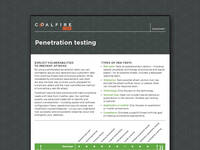
Case Study
Penetration testing - hacking into automotive systems

To keep up with consumer expectations, automotive industry innovation is expanding from Detroit to Silicon Valley. Cars are now more than mere vehicles; they are mobile computers with a growing reliance on connectivity. Many of today’s automobiles feature advanced electronic systems that share information with cloud solutions and put a smartphone at the center of the automotive user interface. But with every additional link comes a larger threat landscape, and therefore, increased risk. In this new reality, automobile security has gone high tech as well.

